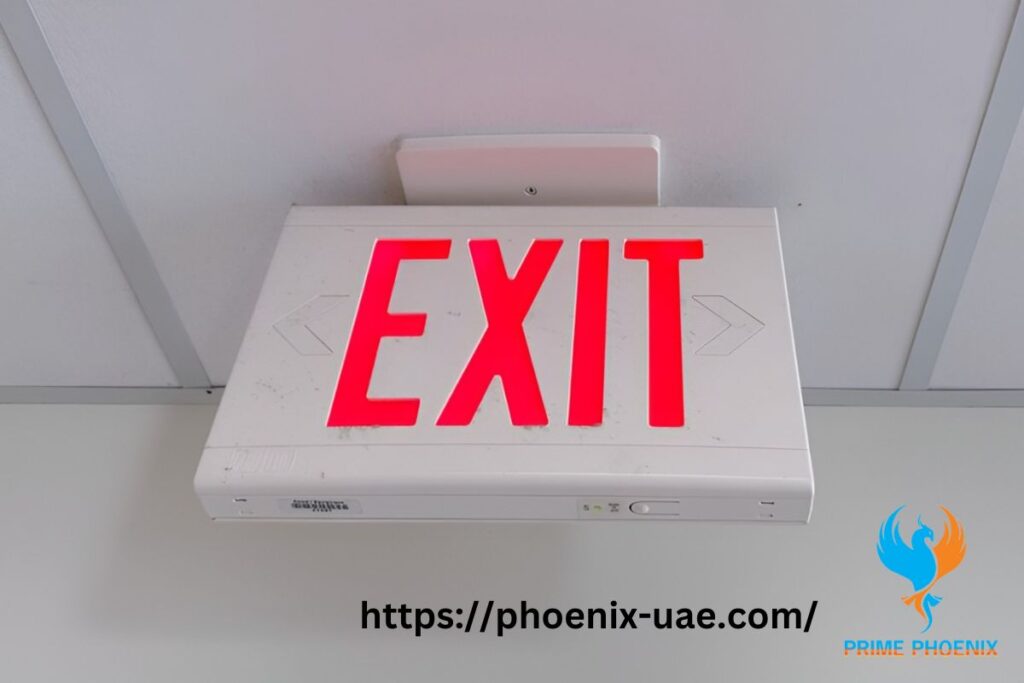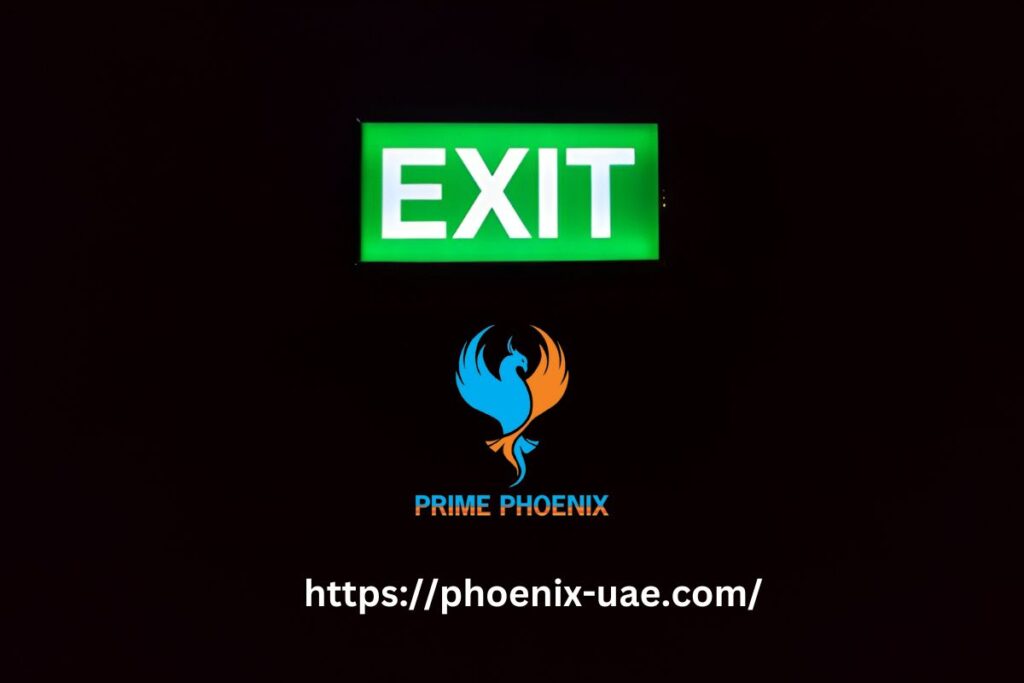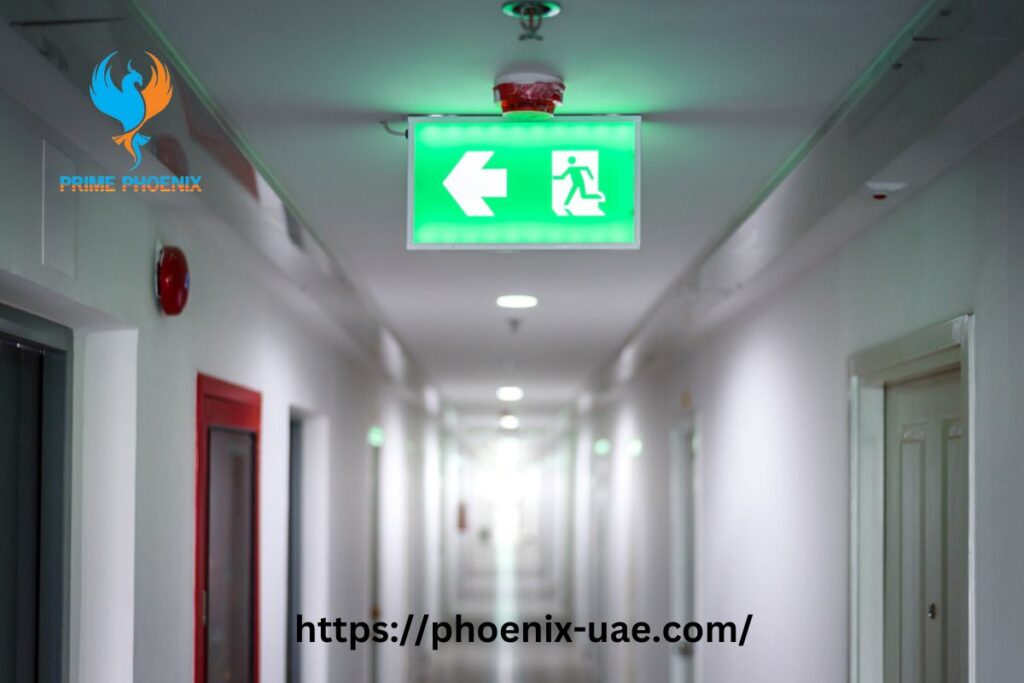- Ras Al Khor Industrial Area 2
- +971 4 330 2170
- +971 547919584

Having clearly marked and illuminated emergency exit lights is an absolute must for the safety of occupants in any building, whether it’s a commercial office high-rise or a local restaurant on the main street. Exit lights play a critical role in safely evacuating people in the event of an emergency by clearly pointing the way to the nearest exit. For building owners and managers, making sure emergency exit signs are installed properly and maintained is not just smart practice, it’s required by law.
As a leading fire safety services provider- Prime Phoenix understands the important role illuminated exit signs play in evacuating people quickly and safely when disaster strikes. We have extensive experience installing, inspecting, and maintaining compliant emergency exit lights to the strict specifications laid out in fire codes and building regulations.
This guide will provide readers with an in-depth look at emergency exit light requirements, types, placement strategies, and maintenance best practices.
Why Exit Lights Are Essential?
When an emergency strikes, panic and confusion often set in. A fire alarm going off or shouts about an intruder immediately puts people on high alert. Add in potential problems like smoke obscuring vision or complete darkness if the power goes out, and the situation can turn deadly very quickly. Exit lights help cut through the chaos by providing instant visibility on where to go to get out safely.
Properly communicating the importance of exit lights is crucial. Appropriate sign placement, visibility and maintenance can save lives in emergencies.

Building Codes on Emergency Exit Lights
Building codes recognize the vital role exit signs play. For example, the International Fire Code (IFC) mandates that exit signs must be placed at multiple locations including:
- At the required exit doorways and exit access doorways from a room or area
- At the exit doorways leading directly outside or to an exit stairway/ramp
- Along the path of egress anywhere the route turns or branches
- Marking the way to exits and exit stairways/ramps when the path is not immediately visible
Simply having generic “Exit” signs or signs over some doors isn’t enough. Exit lights must be strategically installed everywhere occupants may need direction. This extensive coverage ensures a readily visible exit sign will be there no matter where people are located when an emergency hits.
On top of placement, the IFC and other codes also regulate exit sign design and function. Let’s look at what makes an exit sign fully compliant.
Exit Sign Requirements
For an exit sign to effectively serve its purpose, it must be legible, conspicuous, and reliable. Building codes lay out specifications to ensure exit lights meet those crucial standards. Key requirements include:
- Brightness – Exit signs must be illuminated at minimum luminance levels to ensure clear visibility. This applies for both internally lit signs as well as externally illuminated models.
- Distinguishable color – Exit text must distinctly contrast with the background color. Red or green letters on a white background is typical.
- Visibility – Exit signs must be visible from any direction of approach. This means architectural elements can’t obstruct the view.
- Backup power – Exit lights must come on whenever regular lighting fails. This usually requires battery backup integrating into the individual sign or overall building emergency system.
- Durability – Exit signs need to withstand physical impact without compromising function. That’s why durable plastic or steel housings are standard.
- Lettering – The word EXIT must appear in all capital letters at least 6 inches tall. Red or green letters on a white background are typical.
- Placement – Exit signs must be strategically located throughout egress paths anywhere direction changes. Signs must be readily visible from any direction of approach and unobstructed.
At Prime Phoenix, we conduct thorough site assessments to determine precisely where exit signs need to be placed to comply with fire code mandates. Our team handles all necessary permitting and documentation ensuring your exit signage meets both the letter and intent of the law.

Types of Exit Lights
Besides meeting code requirements, exit signs must fit the unique nature of the building. Prime Phoenix offers emergency exit lights in a range of styles, technology types, and feature options. Here are the main types available:
- LED exit lights – LED technology provides long life and energy efficiency. It also allows exit signs to take on a slim, streamlined profile that better complements modern architectural designs.
- Fluorescent exit lights – Previously more common, fluorescent lights take up more space but give off bright, even light. Newer phosphor formulations improve energy performance.
- Incandescent exit lights – The original exit sign type uses tried-and-true incandescent bulbs. While less efficient, these models feature simple reliability.
- Edge lit exit signs – These use LEDs or fluorescent tubes to indirectly illuminate the exit text from the edge. Edge lit signs have a stylish, contemporary look popular in retail and hospitality locations.
- Combination units – Many exit lights integrate backup battery packs or emergency lighting into a single unit. This simplifies installation and maintenance.
Most exit signs now use energy-efficient LED or fluorescent lighting. But incandescent models are still available for standalone use or as backup lights that turn on if the primary lights fail. Every situation is unique. Our team will assess your needs and layout to specify the optimal emergency exit light solutions.

Advantages of Using LED Exit Lights Compared to Fluorescent or Incandescent Ones
Here are some of the key advantages of using LED exit lights compared to fluorescent or incandescent models:
- Energy efficiency – LED exit lights consume far less electricity than fluorescent or incandescent signs. This saves significantly on energy costs over time.
- Long lifespan – LEDs can last up to 10 years or more without needing replacement. This reduces maintenance needs versus changing fluorescent tubes or burnt-out incandescent bulbs more frequently.
- Bright, consistent illumination – LEDs maintain brightness and color quality throughout their lifespan. Fluorescent and incandescent lights gradually dim and change color as they age.
- Durability – LEDs contain no glass or filaments to break. They withstand vibration and drops better than more fragile fluorescent tubes or incandescent bulbs.
- Ideal for cold weather – LED performance isn’t affected by cold temperatures like fluorescent lights. And they don’t require warmup time to reach full brightness.
- Flexible designs – Compact LEDs allow exit signs to take on slimmer, more install-friendly shapes than bulkier fluorescent or incandescent models.
- Instant on – LEDs achieve full illumination immediately when powered on. No warm-up delay like with fluorescent or incandescent exit signs.
- Eco-friendly – LEDs contain no toxic mercury like fluorescent tube lights. And they last longer, so there’s less waste over time.
So in summary, the combination of energy savings, lower maintenance, durability, flexible installation, and instant-on performance make LED exit lights the best choice for most buildings today. The eco-friendly aspect is an added bonus too.

Strategic Exit Sign Placement for Maximum Effectiveness
Exit sign placement is just as important as the sign specifications themselves. If positioned poorly, exit lights can fail to provide effective wayfinding no matter how clearly they shine. Prime Phoenix technicians use best practice placement strategies for the best output.
Here are key guidelines to follow:
- Think visibility – Exit signs do no good if something blocks them. Don’t let decor items, architectural features or other building components obscure the view.
- Look at lighting – Glare or shadows can make exit signs hard to see. Place signs to avoid issues.
- Watch spacing – Code minimums are 15 feet between exit signs. Decrease spacing in challenging areas like complex hallways.
- Note viewing angles – Standard exit signs are designed for perpendicular viewing. Signs for angled viewing may work better in some layouts.
- Mind the height – Mount most exit signs 7-10 feet above the floor where sight lines are clearest.
- Check reflections – Avoid placing exit lights where they will reflect off shiny surfaces. That causes visibility problems.
Proper placement is a process. A thorough walkthrough after hours when signs are illuminated can identify any issues. We examine lighting, sightlines, flows and traffic patterns to determine optimal exit sign locations for your unique needs.

Maintaining Exit Signs
Like any safety equipment, exit signs work best when properly maintained. Prime Phoenix offers complete service plans that extend the life of exit lights and ensure they function when needed
Here are the following:
- Test signs monthly – Run short test cycles to verify lights and backup batteries work.
- Replace batteries as needed – Check manufacturer estimates, but most batteries last 3-5 years.
- Clean signs regularly – Dust buildup diminishes visibility and light output.
- Watch for outages – If any lights burn out, replace bulbs or tubes promptly.
- Repair or replace damaged signs immediately – Don’t wait on physical damage like cracked housings.
- Keep testing records – Thorough logs demonstrate compliance during inspections.
Some exit signs now integrate self-testing features that automatically perform key maintenance steps. These help streamline the process for busy buildings. But hands-on walkthroughs can still catch issues self-tests miss.
Well maintained exit signs mean one less safety concern. Our no-hassle maintenance deals provide guaranteed compliance without tapping your limited staff resources.

Emergency Exit Lights Enhance Safety
In an emergency, seconds count. Exit signs eliminate confusion about which way to escape and provide continuing path illumination when the lights go out. That’s why building codes universally recognize properly installed and maintained exit signs are a basic safety necessity.
For commercial property managers, staying code-compliant is also a legal necessity. But much more importantly, exit signs help fulfill an ethical duty to protect the lives of those entering your building. In a worst case disaster, the exit route visibility exit signs provide can mean the difference between life and death.
Code mandated exit signs help save lives when disasters happen. But only if the signs are lit up throughout the exit path. At Prime Phoenix, we have experience in installing emergency exit lights and proper maintenance to:
- Recommend optimal sign types for your unique needs
- Handle complete installation and documentation
- Ensure ongoing maintenance keeps signs fully functional
Lighting exit pathways to safety is the core reason for exit signs existence. But to serve their purpose, they must be thoughtfully placed, routinely maintained and designed to meet strict visibility and durability standards.
Don’t leave emergency exit sign compliance to chance. Prime Phoenix will make sure your signs meet codes and are ready to safely guide occupants out at the time of worst occur. Contact our team today to get started.
